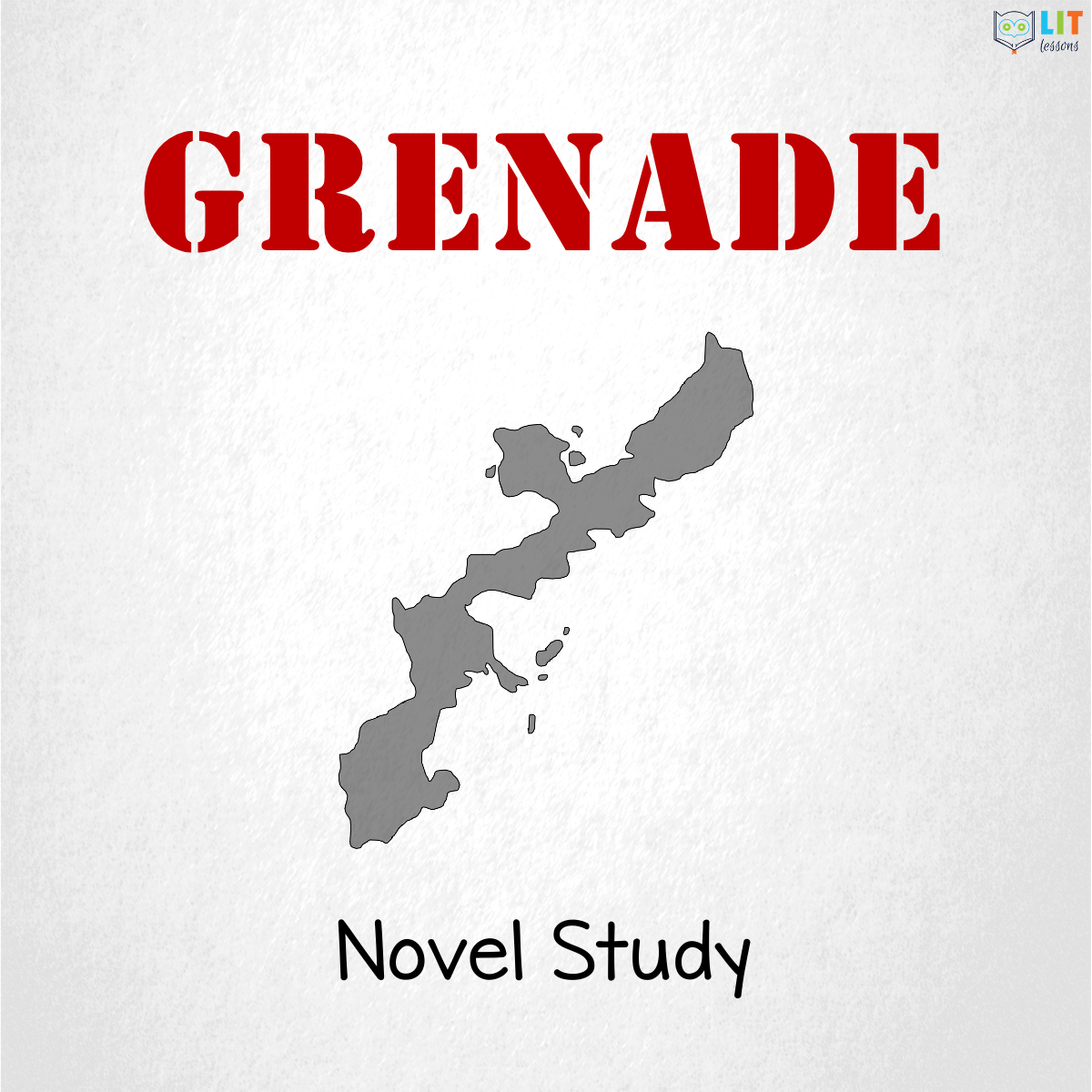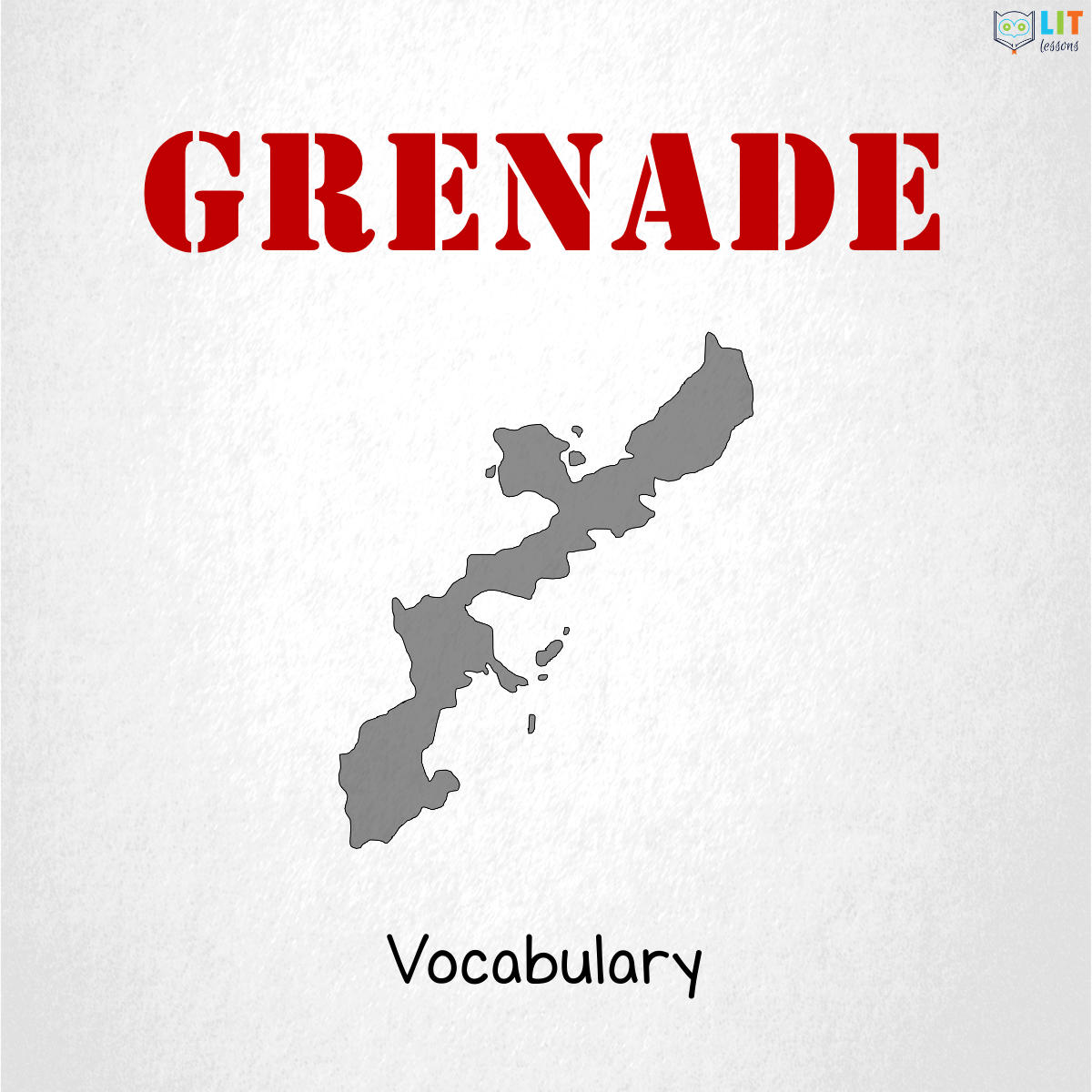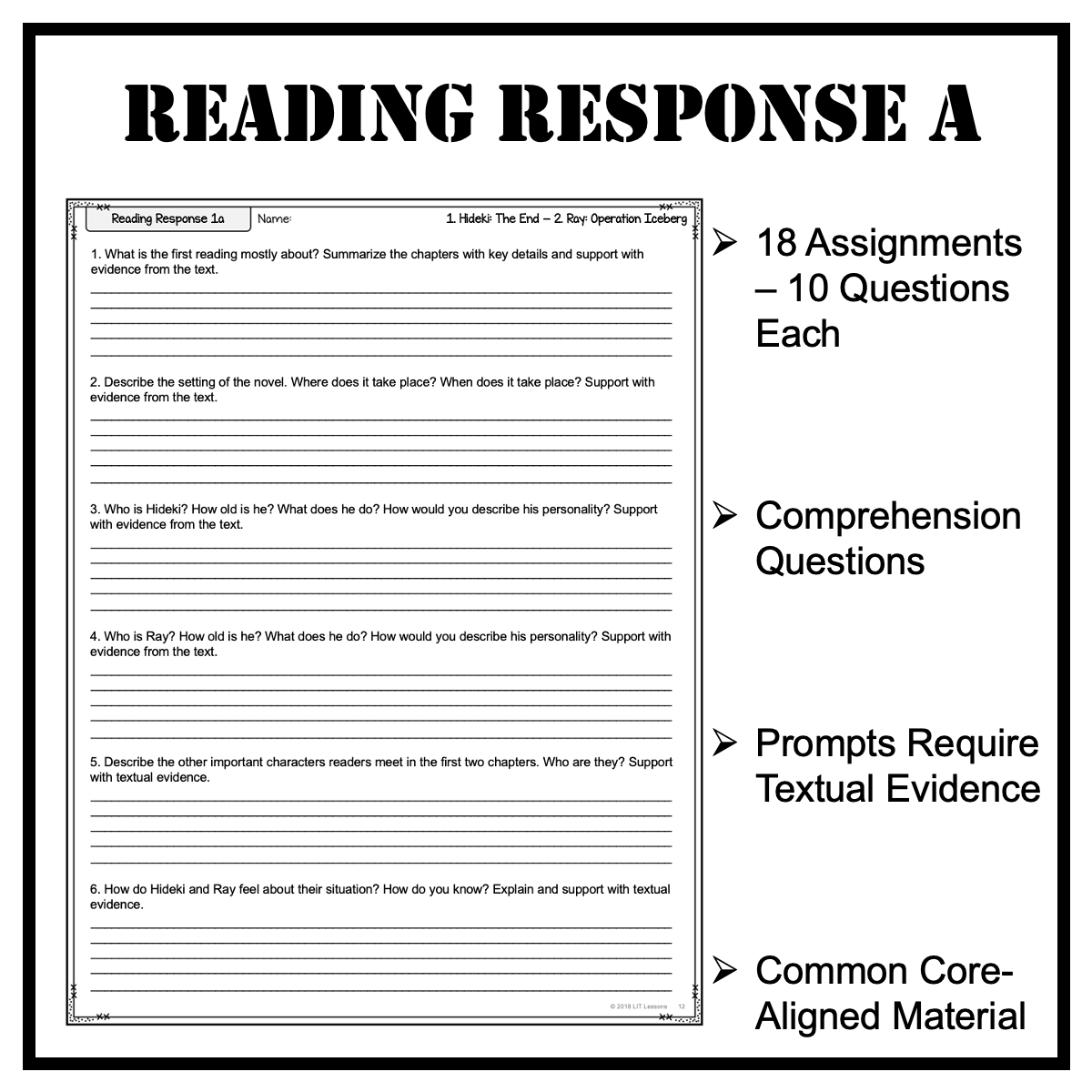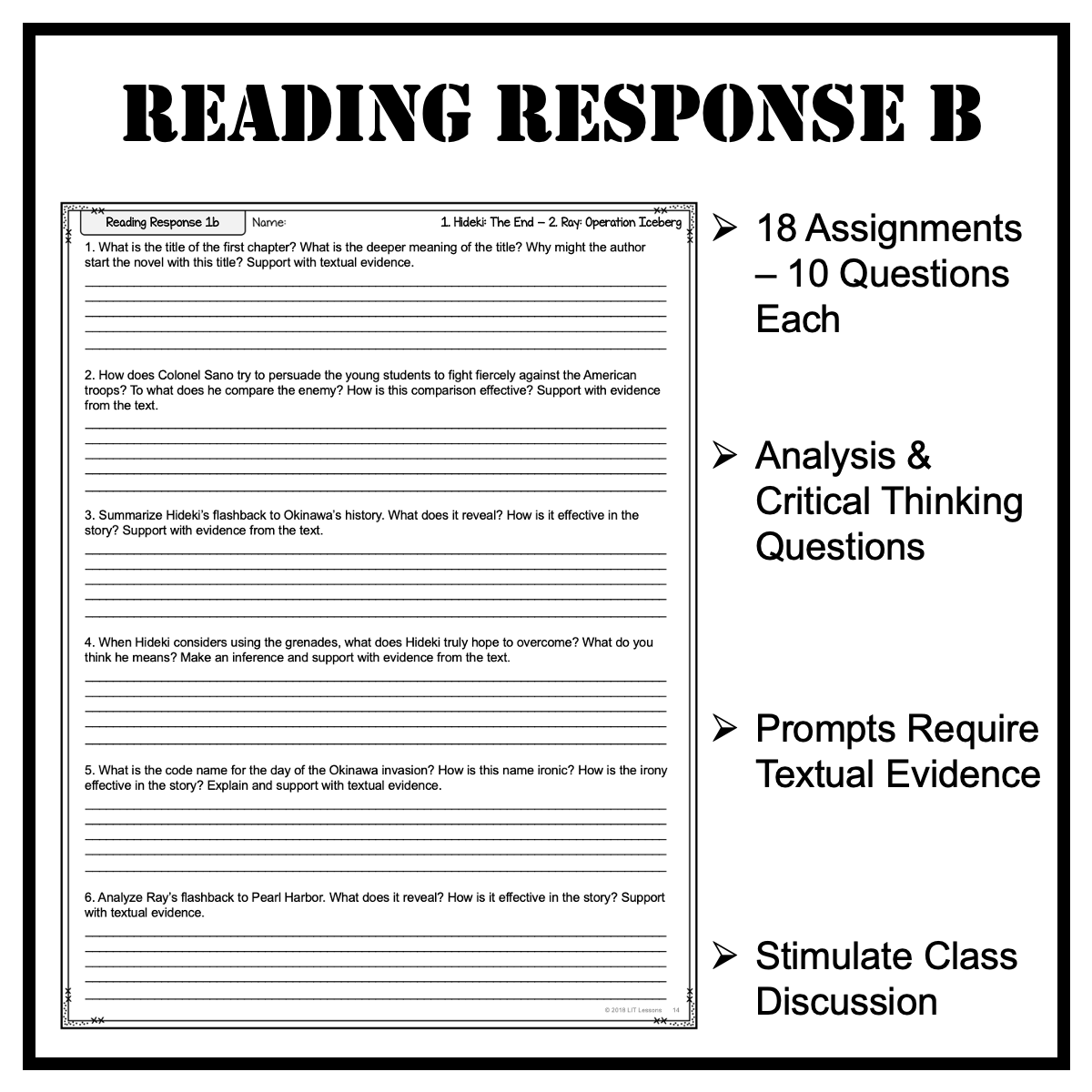Grenade Chapter Questions
You can only add to a wishlist if you have an account, please register now.
Create an Account$10
Grenade Reading Response Resources – Snapshot of Included Resources:
- 18 Comprehension Assignments (A)
- Visualization Organizer (A)
- 18 Analysis Assignments (B)
- Critical Connections Organizer (B)
- 10 Questions per Assignment
- 1-Question Quizzes to Check for Understanding
- Discussion Questions
- Digital Links for Google Slides™
- Pre-Made Text Boxes for Students
- Answer Keys
-
Identifying main idea and support using details from the text
-
Identifying and analyzing parts of plot – how elements of a story interact
-
Identify conflict and types of conflict
-
Analyze how conflict affects characters and creates suspense
-
Analyze character and make inferences about character motivation
-
Identify and analyze symbols for their deeper meaning
-
Identify themes of the text and explain the lesson learned
-
Analyze the effectiveness of flashbacks and foreshadowing
-
Analyze setting for mood and conflict
-
Identify and analyze point of view
-
Make inferences based on textual evidence
-
Identify and analyze irony and how it creates suspense
-
Analyze tone and determine the meaning of words, phrases, and figurative language
- ZIP file (PDFs and Word Docs for Digital Links)
- Non-Editable
- 3.35 MB
- 103 Pages
- Links for Student Pages in Google Slides™
- This downloadable resource supplies one single-teacher license for use in your classroom.
- Photocopying of this product is allowed only for the classroom use of the purchaser.
- Replication of this product, in whole or in part, for commercial sale or broader distribution is strictly prohibited.
- This product also may NOT be shared electronically, digitally, or otherwise in a manner that violates the Terms of Use detailed by LIT Lessons.
- For explicit information on permissions, please see the Terms of Use document included with this resource. Thank you for your cooperation and understanding.
Grenade Reading Response Resources – Snapshot of Included Resources:
- 18 Comprehension Assignments (A)
- Visualization Organizer (A)
- 18 Analysis Assignments (B)
- Critical Connections Organizer (B)
- 10 Questions per Assignment
- 1-Question Quizzes to Check for Understanding
- Discussion Questions
- Digital Links for Google Slides™
- Pre-Made Text Boxes for Students
- Answer Keys
-
Identifying main idea and support using details from the text
-
Identifying and analyzing parts of plot – how elements of a story interact
-
Identify conflict and types of conflict
-
Analyze how conflict affects characters and creates suspense
-
Analyze character and make inferences about character motivation
-
Identify and analyze symbols for their deeper meaning
-
Identify themes of the text and explain the lesson learned
-
Analyze the effectiveness of flashbacks and foreshadowing
-
Analyze setting for mood and conflict
-
Identify and analyze point of view
-
Make inferences based on textual evidence
-
Identify and analyze irony and how it creates suspense
-
Analyze tone and determine the meaning of words, phrases, and figurative language
- ZIP file (PDFs and Word Docs for Digital Links)
- Non-Editable
- 3.35 MB
- 103 Pages
- Links for Student Pages in Google Slides™
- This downloadable resource supplies one single-teacher license for use in your classroom.
- Photocopying of this product is allowed only for the classroom use of the purchaser.
- Replication of this product, in whole or in part, for commercial sale or broader distribution is strictly prohibited.
- This product also may NOT be shared electronically, digitally, or otherwise in a manner that violates the Terms of Use detailed by LIT Lessons.
- For explicit information on permissions, please see the Terms of Use document included with this resource. Thank you for your cooperation and understanding.



More Grenade Resources...
Grenade Novel Study
The Grenade Novel Study is a comprehensive set of standards-aligned instructional materials for teaching Grenade by Alan Gratz. With over 100+ materials, students will deeply engage with the novel and develop their literacy skills. The close reading activities, literary analysis resources, WWII Pacific Theater nonfiction readings and activities, vocabulary, assessments, and final projects all provide opportunities for your students to practice and apply what will be their growing understanding of the novel. They also provide numerous ways for you to DIFFERENTIATE learning for your students, allowing you to choose the assignments that best support your students’ learning while being conducive to any classroom model.
Grenade Close Readings
The 18 close reading lessons explicitly focus on critical Common Core State Standards to develop students’ literacy proficiency. Using Grenade as the foundational text for close reading, each lesson focuses on a particular skill, such as setting, conflict, tone, and plot, and provides students an opportunity to develop and demonstrate their ability to perform that skill. Each assignment also requires students to use textual evidence to support their claims. The resources could supply homework, facilitate guided reading groups, or stimulate whole class literacy discussions for each chapter grouping. You can choose the purpose that best suits your students and your classroom.
Grenade Assessments
The standards-aligned assessments will help you measure your students’ comprehension of Grenade and their ability to apply the literary skills taught throughout the unit. The materials include 18 reading checks, 2 novel quizzes, 3 final assessments, and essay prompts.
Grenade WWII Pacific Theater Nonfiction Readings & Activities
World War II’s Pacific Theater often receives less attention when studying the global conflict. Yet, it played a pivotal role in the War, and events in the Pacific Theater dramatically shaped the post-War global order. The 18 readings, 9 activities, and project provide a comprehensive set of materials to help students understand the Pacific Theater, a complex yet critical topic for helping students develop an expansive view of world history. They will also build background knowledge to better help them understand Grenade. With these resources, students will engage in a range of activities to deepen their knowledge of the events leading up to WWII, fighting in the Pacific Theater, the effects of war, and more. All the resources are aligned to Common Core State Standards and will allow students to develop essential skills, such as close-reading, critical thinking, examining perspectives, making an argument, and conducting and presenting research, among others. In the end students will not only have broadened their horizons but also own their abilities.
Grenade Vocabulary
The vocabulary resources will engage students in varied activities to expand their vocabulary. The resources include materials to help teach challenging vocabulary words in Grenade that will then build your students’ vocabulary. With 6 vocabulary lists of 10 words each and a crossword puzzle and quiz for each set, the materials provide opportunities for differentiation to suit the needs of the classroom.

Grenade Novel Study
The Grenade Novel Study is a comprehensive set of standards-aligned instructional materials for teaching Grenade by Alan Gratz. With over 100+ materials, students will deeply engage with the novel and develop their literacy skills. The close reading activities, literary analysis resources, WWII Pacific Theater nonfiction readings and activities, vocabulary, assessments, and final projects all provide opportunities for your students to practice and apply what will be their growing understanding of the novel. They also provide numerous ways for you to DIFFERENTIATE learning for your students, allowing you to choose the assignments that best support your students’ learning while being conducive to any classroom model.

Grenade Close Readings
The 18 close reading lessons explicitly focus on critical Common Core State Standards to develop students’ literacy proficiency. Using Grenade as the foundational text for close reading, each lesson focuses on a particular skill, such as setting, conflict, tone, and plot, and provides students an opportunity to develop and demonstrate their ability to perform that skill. Each assignment also requires students to use textual evidence to support their claims. The resources could supply homework, facilitate guided reading groups, or stimulate whole class literacy discussions for each chapter grouping. You can choose the purpose that best suits your students and your classroom.

Grenade Assessments
The standards-aligned assessments will help you measure your students’ comprehension of Grenade and their ability to apply the literary skills taught throughout the unit. The materials include 18 reading checks, 2 novel quizzes, 3 final assessments, and essay prompts.

Grenade WWII Pacific Theater Nonfiction Readings & Activities
World War II’s Pacific Theater often receives less attention when studying the global conflict. Yet, it played a pivotal role in the War, and events in the Pacific Theater dramatically shaped the post-War global order. The 18 readings, 9 activities, and project provide a comprehensive set of materials to help students understand the Pacific Theater, a complex yet critical topic for helping students develop an expansive view of world history. They will also build background knowledge to better help them understand Grenade. With these resources, students will engage in a range of activities to deepen their knowledge of the events leading up to WWII, fighting in the Pacific Theater, the effects of war, and more. All the resources are aligned to Common Core State Standards and will allow students to develop essential skills, such as close-reading, critical thinking, examining perspectives, making an argument, and conducting and presenting research, among others. In the end students will not only have broadened their horizons but also own their abilities.

Grenade Vocabulary
The vocabulary resources will engage students in varied activities to expand their vocabulary. The resources include materials to help teach challenging vocabulary words in Grenade that will then build your students’ vocabulary. With 6 vocabulary lists of 10 words each and a crossword puzzle and quiz for each set, the materials provide opportunities for differentiation to suit the needs of the classroom.








